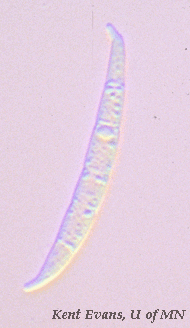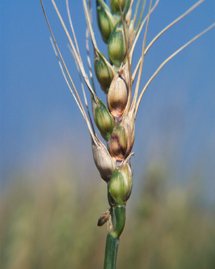Fusarium graminearum
A Microbial Biorealm page on the genus Fusarium graminearum
Classification
Higher order taxa
Eukaryota; Fungi; Ascomycota
Species
Fusarium graminearum
Description and significance

F. graminearum is commonly found on cereal grains, most commonly on wheat and barley. On wheat, the spores germinate on the kernel and grow down the stalk. Fruiting structures penetrate through the wheat's stomates. The kernels will appear visually "scabby". The macroconidia of F. graminearum are almost cylindrical in shape, with the central dorsal and ventral surfaces parallel. They most often contain five septa (Doyle and Beuchat, 2007) The end of the macroconidia are slightly bent in a "banana-like" formation with a foot cell or tiny knob at the tip.
F. graminearum, Fusarium Head Blight in particular, has major economic impacts. Diseased crop cost
Describe the appearance, habitat, etc. of the organism, and why you think it is important.
Genome structure
The genome of F. graminearum is made up of an assembly of plasmid, fosmid, and bacterial artificail chromosome, totaling 36.1 Mb and displaying high sequence quality and continuity. It is predicted that the genome contains a set of 11,640 genes and four chromosomes. Certain regions of the chromosomes have been found to have high levels of polymorphisms and high levels of recomination between strains of the species. An interesting feature of this observation is that genes that are specifically expressed during plant infection are all over-represented in high density single nucleotide polymorphic regions. The genome appears to have very few repetative sequences with fewer high-identity duplicates. It has been speculated that this is the result of repeat-induced point mutations.
Cell structure and metabolism
Fusarium graminearum possess a distinctive “banana-shaped,” macroconidia. These conidia contain multiple septa and often have a “foot cell.” Once conditions are favorable, these conidia produce ascospores to promote its dispersal. (Goswami 516)
Fusarium graminearum uses glucose as a carbon source for energy and undergoes aerobic respiration. The heterogeneous composition of the cell wall is particularly important for the pathogenicity of F. graminearum, as it contains multiple accessory proteins for electron transport as well as chitinase, and important enzyme for the degradation of chitin. (Shi et al. 371)
The myotoxins, which include culmorin, trichothecene deoxynivalenol, and zearalenone produced by F. Graminearum as secondary metabolites, is what causes its pathogenicity.
Ecology
F. Graminearum infected grains have been discovered in a broad range of environments. This includes wheat and barley in North America, Asia, Canada, Europe, and South America. It has inhabited both temperate and semitropical regions. (Goswami 515) The type of grains Fusarium has infected is almost diverse as the area is inhabits, causing “scab,” on what, rice, oats, and maize. (Geraldo et al. 58)
Fusarium Graminearum is best known for the detrimental interactions it has with various grains. Regions of highest disease occurrence include the Red River Valley, the Midwest and Mid-Atlantic areas of North America, in addition to the Ottawa Valley and parts of Ontario in Canada. (Gunether 2)
Pathology

F. graminearum is best known as a plant pathogen. It causes various diseases of cereal grains, such as gibberella ear rot in corn and fusarium head blight or scab in wheat and other grains.
Toxic metabolites of the mold have been found to be toxigenic in humans. The major mycotoxins produced by F. graminearum are deoxynivalenol and zearalenone. Other toxins that may be produced by some strains include 3-acetyldeoxynivalenol, 15-acetyldeoxynivalenol, diacetyldeoxynivalenol, butenolide, diacetoxyscirpenol, fusarenon-X, monoacetyoxyscirpenol, neosolaniol, nivalenol, or T-2 toxin (Marasas and others, 1984).
How does this organism cause disease? Human, animal, plant hosts? Virulence factors, as well as patient symptoms.
References
Cuomo, C., Guldener, U., Xu, J., Trail, F., Turgeon, B., Di Pietro, A., Walton, J., Ma, L., Baker, S., Rep, M., Adam, G., Antoniw, J., Baldwin, T., Calvo, S., Chang, Y., DeCaprio, D., Gale, L., Gnerre, S., Goswami, R., Hammond-Kosack, K., Harris, L., Hilburn, K., Kennell, J., Kroken, S., Magnuson, J., Mannhaupt, G., Munsterkotter, M., Nelson, D., O'Donnell, K., Ouellet, T., Qi, W., Quesneville, H., Roncero, M., Seong, K., Tetko, I., Urban, M., Waalwijk, C., Ward, T., Yao, J., Birren, B., Kistler, H. "The Fusarium graminearum Genome Reveals a Link Between Lacalized Polymorphism and Pathogen Specialization". Science. 2007. Vol. 317. p. 1400-1402.
Marasas, W.F.O., Nelson, P.E., Tousson, T.A. 1984. Toxigenic Fusarium Species: Identity and Mycotoxicology. The Pennsylvania State University Press, University Park, Pa.
Doyle, M.P., Beuchat, L.R., Food Microbiology: Fundamentals and Frontiers. 2007. ASM Press. Washington, DC.
Spore Image. 2005. http://www.ars.usda.gov/SP2UserFiles/ad_hoc/36400500Fusarium/spore.gif.
Fusarium Head Blight (scab). 2007. http://www.ars.usda.gov/Main/docs.htm?docid=9756.
Edited by student of Emily Lilly at University of Massachusetts Dartmouth.
Geraldo, Marcia Regina.., Dauri Jose Tessmann, and Carlos Kemmelmerier. “Production of mycotoxins by Fusarium Graminearum isolated from small cereals (wheat, triticale and barley) affected with scab disease in Southern Brazil,” Brazillian Journal of Microbiology, 37: 58-63. (2006).
Goswami, Rubella S., and Kistler Corby H. “Heading for disaster: Fusarium Graminearum on cereal crops,” Molecular Plant Pathology, 5: 515-525. (2004).
Guenther, John C., 2003: The Colonization of Wheat Stems and Subsequent Perithecium Development by Gibberlla Zeae (Anamorph Fusarium Graminearum), MS thesis, Michigan State University, 1-33.
Shi, Zhiqi. Shouguo Shen, Zhou Wei, Wang. Fen, and Yongjian Fen., “Fusarium Graminearum Growth Inhibition Due to Glucose Starvation Caused by Osthol,” International Journal of Molecular Sciences, 9: 371-381. (2008).
